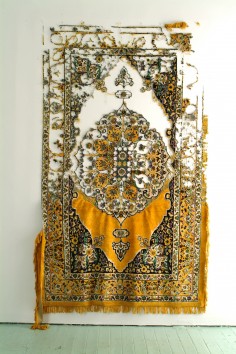ELANA HERZOG
Civilization and its Discontents
source: highlike
Work: Elana Herzog is one of several artists working today whose installations draw from the pared down traditions of minimalism and the bravura experimentation of arte povera. …. Herzog’s practice is to attach distressed discarded textiles such as old bedspreads, tablecloths or carpets directly to a wall using hundreds of metal staples. She then tears away at the fabric and selectively reapplies these cloth shreds with more staples, arriving at progressively dematerialized works she terms “sculptural drawings.” The heavily built-up areas of cloth and dense patterns of metal staples play against the skin of the bare, perforated gallery wall, suggesting the precarious physical presence of her constructions. They are simultaneously being made and unmade, new forms emerging from the remains of the old. Though Herzog’s initial inspiration derives from the monolithic rectangles of Sixties abstract painting, she proceeds to challenge modernism’s conventions of the integrity of the object by injecting references to the violent disregard and destruction of the planar surface. She describes her debt to modernism as both reverent and irreverent.
Goldman, Judy Ann, “Elana Herzog: Re Constructions: Sculpture and Works on Paper”, Arts New England, July/August 2013
About: Elana Herzog lives and works in New York City. She is preparing for a two person show at the Pierogi Boiler, in Brooklyn, New York that will take place in the fall of 2014. Herzog is the 2012 Fellow of the Saint-Gaudens Memorial in Cornish, New Hampshire, which recently mounted a solo exhibition of her work. Other solo and two person exhibitions include Plumb Pulp 2014, and Into the Fray 2011, at Lmak Projects in New York City, De-Warped and Un-Weft, a survey of Herzog’s work since 1993, at the Daum Museum of Contemporary Art in Missouri in 2009. the Aldrich Museum of Contemporary Art in Connecticut, Smack Mellon in New York, the Herbert F. Johnson Museum at Cornell University, in New York, Morgan Lehman Gallery, and PPOW Gallery, New York City, and Diverse Works in Texas, the Zilkha Gallery, Wesleyan University, Connecticut. Her work has been exhibited internationally at the Reykjavik Art Museum, Reykjavik, Iceland, in Sweden at Konsthalle Goteborg and at Konstahalle Gustavsbergs, and Tegnerforbundet in Oslo, Norway, among other venues.Herzog has participated in numerous group shows at institutions such as the Tang Museum in Saratoga Springs. New York, the Weatherspoon Museum in Greensboro, North Carolina, The Brooklyn Museum, and The Museum of Arts and Design, both in New York City.
Herzog has been a resident at he Josef and Annie Albers Foundation, in Bethany, Connecticut, at Gertrude Contemporary in Melbourne, Australia, the Farpath Foundation Residency in Dijon, France, and the Marie Walsh Sharpe Space Program Residency in Dumbo, New York. She has been awarded the Anonymous Was A Woman Award in 2009, the Louis Comfort Tiffany Award in 2007, the NYFA Individual Artist’s Fellowship in 2007 and 1999, the 2004 Lillian Elliot Award, the 2003 Lambent Fund Fellowship and the 1999 Joan Mitchell Award. She was a 2008-2009 Workspace Resident of the Lower Manhattan Cultural Council, and Dieu Donne Paper.
Herzog has been a Lecturer in the Sculpture Department at Yale University since 2012.
Photographer: Hermann Feldhaus
.
.
.
.
.
.
.
source: elanaherzog
Persian and Persian type carpets, mixed fabrics, metal staples, Dimensions variable
Civilization and it’s Discontents began in early 2003, as the U.S. was preparing to invade Iraq. The first version was exhibited at Smack Mellon, a non profit gallery in Brooklyn, New York, where they filled a small project space. It utilized Persian and Persian type carpets, including two that were based on the image of an Afghan War rug made in the 1980’s. These carpets, which vary so dramatically in quality and condition are to be found in every imaginable corner of our society, from the garbage heap to the museum, and of course, at Wal-Mart. They run the gamut of production and use values, employ various technologies and embody a range of motivations, from spiritual to economic.
.
.
.
.
.
.
.
source: anabundanceof
Elana herzog’s civilization and its discontents.
she created most of her pieces by stapling found textiles to
walls using metal staples. she first attaches textiles,
mostly bedspreads and carpets, then removes them and sometimes reapplies them. they look like delicate shredded fabrics, i am intrigued.
.
.
.
.
.
.
.
source: ndhvn
Elana Herzog nói về công việc của mình: “Vật liệu tôi sử dụng thường rẻ, cũ, hoặc là đồ bỏ đi. Chính sự cũ kỹ của chúng đem đến cho tôi thách thức về sự tận hưởng và cái đẹp. Nó thu hút sự chú ý đến cách mà nghệ thuật xâm nhập vào các nền văn hóa khác nhau, từ cao đến thấp và ngược lại. Điều đó được giải thích theo chiều hướng phát triển của của công nghiệp hóa nhằm đáp ứng nhu cầu khác nhau thị trường và xu hướng xã hội. Công việc của tôi nhằm tạo ra một mối liên kết, mỏng manh thôi, giữa lực hút và lực đẩy, giữa nỗi đau và niềm vui, giữa sự thô tục và cao sang… Sự sáng tạo của tôi có một mối quan hệ với sự hiện đại hóa theo cả hai hướng ủng hộ và phản đối. Đây là ngôn ngữ của riêng tôi, nhưng tôi chưa bao giờ cảm thấy quyền sở hữu của mình với nó. Từ vị trí của sự chán ghét hiện thực, công việc của tôi thể hiện mối quan hệ song song với tàn tích của cả hai nền văn minh cao và thấp.”


